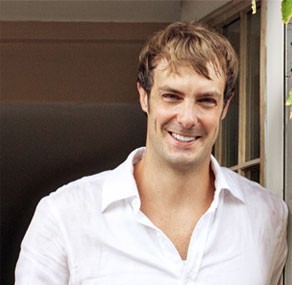 Barton Seaver
Barton Seaver
Barton Seaver knows how to work magic with seafood. As executive chef at the Washington, D.C., restaurant Hook, he has won acclaim for his focus on sustainable seafood. His efforts have earned him a National Geographic fellowship and recognition from the Seafood Choices Alliance and the Monterey Bay Aquarium.
Seaver believes that ensuring the survival of the oceans means changing our relationship with seafood, not severing it completely, and that chefs can use their influence to lead this change. His first cookbook, For Cod and Country, offers simple, seasonal, and scrumptious recipes as alternatives to the obvious seafood choices that have become unsustainable for our ocean ecosystems.
Q. What sparked your interest in seafood in general and sustainable seafood in particular?
A. I’ve long had a love affair with seafood. It was my dad’s favorite thing to cook, and that’s where I learned my fluency with food, in my dad’s kitchen. To put forward the best plate of food that you can, you start with the best ingredients you can find. I took a step back from the plate, took myself off of it, and began to really laud the ingredients. And more often than not those [ingredients] were coming from local farms. It was sustainable agriculture that got me interested in sustainable seafood as well. Very much the same ethics applied to that product.
The book For Cod and Country is really a tool that I wrote to help Americans eat more seafood, and for retailers and restaurants to cater to better-educated consumers.
Q. Some people take the hard line that our oceans are so depleted and overfished that we shouldn’t be eating seafood at all. Why do you think it’s important for us to keep eating seafood?
A. I take an approach that all of us ate our way into our current predicament. And if we have eaten our way into this challenge, I believe we can eat our way out of it. Yes, fishing practices need to change, management policies need to change, consumer practices need to change. I really believe in the power of restorative seafood. Currently we’re so depleted that what we need to talk about is restoring populations, before we can even begin to think about sustaining the levels of them.
The Monterey Bay Aquarium and the Blue Ocean Institute published a wallet guide that ranks seafood as green list, yellow list, or red list. Consumers understand sustainable seafood as [being on the] green list. But we’re tasked ultimately with changing the fate of the species on the yellow and the red list. And sometimes the best way to do that may actually be to eat them. Sometimes by supporting the right players in the wrong industry, you actually help to change the whole industry. It’s about not just restoring ecosystems, but restoring sustainable economic systems that are based off of this sustainable resource.
Q. What roles do consumers and chefs play in restoring and maintaining sustainable seafood systems?
A. One of the big problems with seafood and our cultural identification of it is that we’ve commoditized it. We take our preordained recipes and we walk into a grocery store and we say, “I need salmon.” And we force the retail system, we force the production system, we force fisheries to have salmon available to us at all times. If we’re to participate in an ecosystem in the way that an ecosystem actually works, then we should walk into a grocery store as consumers and say, “What do you have that’s freshest, what do you have that’s best, what do you have that’s most economical, seasonal, and local?” But right now we race to the grocery store and say, “I want the most obvious choice.”
The guiding hand of natural selection, I believe, has really become that of the cook. If it’s chefs who can decimate bluefin tuna, who can put Chilean sea bass on every menu across the globe, if it’s chefs who have the power to destroy and make the environment and people sick, so too do chefs have the power to restore and heal. The role of chefs is to educate and entertain and take species like mackerel or bluefish and make these acceptable, to introduce them to the consumer. Chefs can begin to break down these cultural taboos of eating something [you’ve never heard of]. That way retailers would be encouraged to thus participate in the local economy, to allow fishermen to own their product further through the supply chain. Fishermen could catch their daily quota, come to the market, and say, “OK, here’s what I got.” And consumers would race to them and say, “I want the freshest one.”
Q. So chefs can act as a go-between for the consumers and the fishers?
A. Yes, they can, but also, chefs, I think, for too long have been relied upon to carry the science of sustainable fishing, which is not a chef’s expertise. Many chefs aren’t comfortable in the communicator role. Most chefs are not marine biologists. I don’t understand exactly how ecosystems work. I’m just giving it my best shot, trying to reiterate and translate science into the lexicon of dinner. What chefs can really do is sell the human story: Hey, these fishermen are trying to do the right thing, they’re trying to engage the next generation, so their children might be able to follow in their footsteps, might be able to keep this community a working waterfront.
There’s another big thing chefs can do. We focus so much on whether the product is sustainable that we forget to use these products sustainably. You can have sustainable Alaskan salmon caught by the Eyak tribesmen who’ve been fishing there for 3,500 years, and it’s shipped to you in a carbon-neutral way, and you’re supporting a historical and holistic viewpoint of how man and nature can coexist in a beautiful way, what an incredible story — here’s your 12-ounce steak of salmon. Just because it’s a sustainable product doesn’t mean we can [forget that we should be eating] small, adequate, but enjoyable portions. We need to be getting most of our calories from vegetables. You want to save the oceans? Great, eat vegetables. That’s really where a chef can put his or her foot into the ring, is by taking seafood and moving it away from the center of the plate.
Q. What if you’re on a budget, or you live far away from major bodies of water? Can you still make good choices about eating seafood?
A. Well, the fact that we import 80 percent of the seafood that we eat and we export 60 percent of the seafood that we catch in this country says that even if you’re in a coastal city, you are far away from the actual source of your fish to begin with. Some of the most obvious, easy, economical, and accessible sustainable seafoods come in a can. Anchovies, sardines, herring, oysters, clams, mackerel, mussels, pink salmon. Even tuna — there’s a lot of tuna out there that’s really a very good product. I feature a lot of canned seafood in my recipe book, from canned sardine salad with mesclun and fig and olive vinaigrette, to thin-sliced heirl
oom tomatoes with a sardine vinaigrette, to pink salmon with shaved fennel and basil. Pink salmon is highly sustainable. It’s the largest volume salmon fishery. You have low transportation impact, zero waste, it’s cheap and it’s accessible, it’s negligible in any toxicity, it’s super high in omega-3, and it’s available. So are sardines. We have this weird cultural taboo against eating sardines.
Q. What’s your favorite kind of seafood?
A. It changes by season, because what’s freshest and what’s best, what’s still clinging to its curved form while in rigor mortis just off the boat, that fish is going to trump whatever preference I bring to the table in terms of quality. But I would say oysters, clams, and mussels. It’s our patriotic duty to eat as many farm-raised shellfish as we can. It’s the only seafood that I recommend overconsumption of. Oysters are an absolutely decimated wild population, and they provide a very necessary and vital ecosystem function of helping to filter the waterways. When an oyster farmer plants a clam or an oyster, that farmed oyster is the exact same species that goes in the wild, and it performs the same vital functions. In fact, in some cases, those oysters will actually breed and reproduce, thus helping to replenish and restore native populations. Every time you eat one of these farmed oysters you’re incentivizing the farmer to plant at least one more. And that creates a vital economic lifeline for areas that are devastated by overfishing.
So as I say at the beginning of my book: environmentalism on the half-shell with a six-pack of beer and some Tabasco — count me in.


